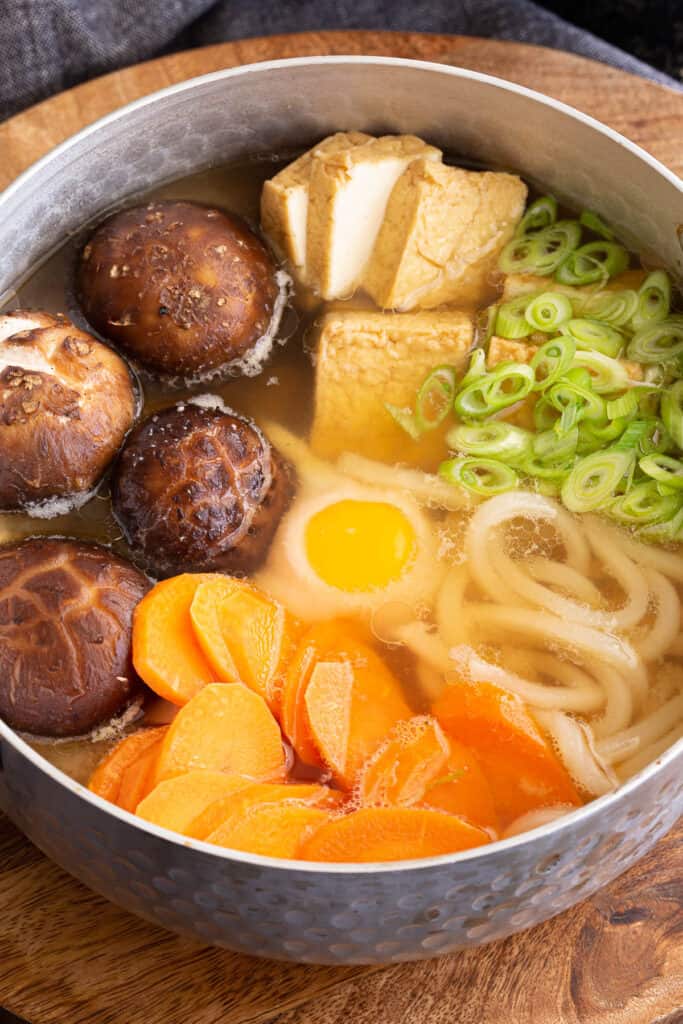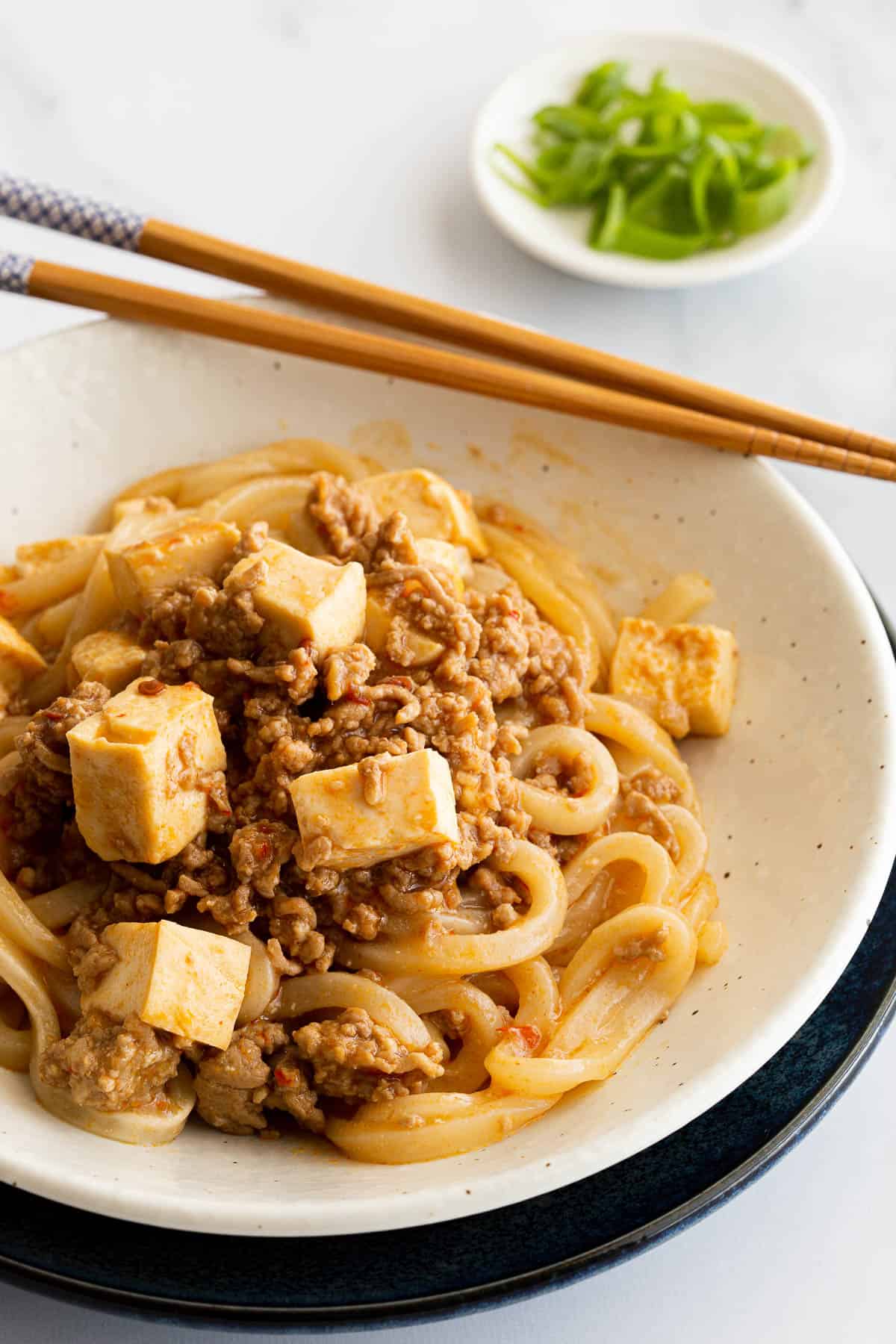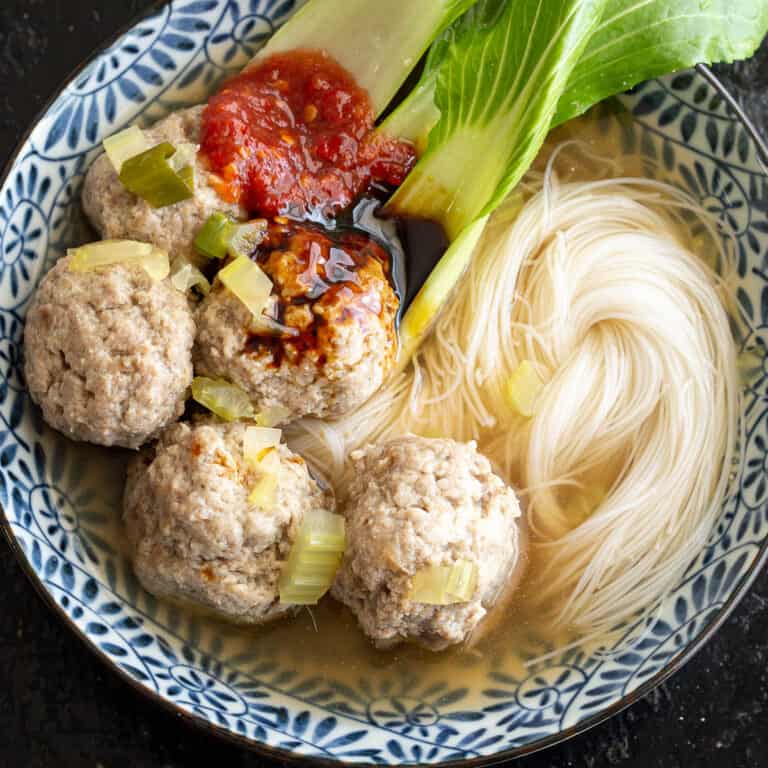Miso Nikomi Udon – Miso Udon Soup
When it’s cold outside, make miso nikomi udon! This warm and comforting miso udon soup is filled with chicken, mushrooms and fried tofu to fill you up. The dashi and miso infused broth is full of umami flavour and will warm you up from the inside out.

Why We Love This
Miso nikomi udon looks gorgeous and is so easy to prepare, with the chewy udon noodles, bite-sized chicken pieces and mushrooms simmered directly in the miso dashi broth.
It’s such a warming soup to enjoy on a cold winter’s night, and filling without being heavy on the stomach.
The soup is full of umami flavour, and while there are some classic ingredients that are usually included, you can easily adapt the recipe to use up leftovers or your favourite ingredients.
Related: Miso Soup / Homemade Udon Noodles / Tsukemen Dipping Ramen
Should I add raw egg?
Miso nikomi udon is traditionally served with a raw / partially cooked egg. If you’re based in a country where it is safe to eat raw eggs, you can crack 1-2 eggs in the centre of the pot, and partially cook, uncovered, for a few minutes. Carefully transfer the yolk into a small dipping bowl and dip the soup ingredients (noodles, chicken etc) into the egg yolk for an extra creamy experience!
If you are based in a country where it is unsafe to eat raw eggs, please skip this step or learn how to pasteurise raw eggs before you proceed.

What is Miso Nikomi Udon?
Miso nikomi udon (味噌煮込みうどん) is a noodle soup that originated in the area of Nagoya, Japan.
Nikomi means “boiled” or “stewed”, and the name refers to how the ingredients are simmered in a dashi and miso based broth.
This style of miso udon soup is usually made with chicken, raw eggs, tofu and vegetables, but can sometimes include other special Japanese ingredients like kamaboko (Japanese fish cake) and aburaage (fried tofu pouches).
What You’ll Need
- Dashi Stock Powder – This is our favourite shortcut to save time on making dashi stock from scratch. You can find it in two different styles – kombu dashi (vegan) or hondashi (made with smoked dried bonito). If you feel like taking things further you can always make your own dashi stock from scratch with fresh kombu and katsuobushi (bonito flakes).
- Chicken – We use boneless, skinless chicken thighs so they stay nice and juicy while simmering in the broth. Sub with thinly sliced hot pot style pork, or top with other Japanese favourites such as tempura or sliced kamaboko fish cake.
- Miso – We use a combination of red miso and white miso for a nice balance of umami and sweetness. If you only have one style, just use that.
- Mirin – This is a sweet rice wine for cooking. You can sometimes find it in regular supermarkets, otherwise head to your nearest Asian grocer or online. If you don’t have it, just leave it out and add in a 1 tsp of sugar instead.
- Udon Noodles – Fresh udon noodles if you can, otherwise frozen or shelf-stable udon noodles will also work well depending on what’s available in your area. Sub with soba noodles, ramen noodles or Chinese style egg noodles in a pinch.
- Shiitake Mushrooms – You can use dried shiitake mushrooms if you can’t source fresh ones. To reconstitute, soak them in cold water overnight. Otherwise, sub with enoki mushrooms, chopped oyster mushrooms or white button mushrooms.
- Carrot – Thinly sliced so they cook through quickly and evenly.
- Fried Tofu – We use store-bought fried tofu. Sub with firm tofu if you need. You can then fry it or add it fresh into the stock.
- Garnish – Spring onion, shichimi togarashi, aonori seaweed flakes and/or katsuobushi.
Wandercook’s Tips
- Don’t Overcook – If you do, you’ll lose the bright colours of your ingredients and may cause the udon noodles to become soft and break apart in the soup.
- Presentation – For the best presentation, cook and serve the miso udon soup in individual donabe (clay pots). If you don’t have one, just cook in a regular pot on the stove and ladle out into serving bowls.
FAQs
Miso udon soup is best enjoyed immediately after cooking. You can save leftovers in an airtight container in the fridge overnight, but if possible store the noodles separately to stop them absorbing all the soup liquid.
Reheat on the stove so you can add more water or stock as you need until it’s fully heated through.
Variations
- Serve Over Rice – Ladle ingredients on top of cooked rice to soak up the soup, or serve separately as a nice palate cleanser between spoonfuls.
- Miso Paste – While we used both white and red miso in this recipe, feel free to only use one or the other if you prefer.
- Protein – Swap the chicken for thinly sliced pork or beef, similar to shabu shabu or sukiyaki hot pots.

More udon noodle goodness to try next:




★ Did you make this recipe? Please leave a comment and a star rating below!
Equipment
Ingredients
- 2 cups water
- 2 tsp dashi powder
- 2 boneless chicken thighs approx 300 g / 10 oz, chopped into bite-size pieces
- 1 tbsp red miso paste
- 1 tbsp white miso paste
- 2 tbsp mirin
- 240 g udon noodles fresh or frozen, sub ramen noodles
- 4 shiitake mushrooms sliced (sub enoki or white button mushrooms)
- 1 carrot sliced in diagonals
- 100 g fried tofu sliced into bite-sized pieces
Optional Toppings
- spring onion thinly sliced
- shichimi togarashi
- eggs
Instructions
- Place the water and dashi powder into a medium saucepan and bring to a boil. Add the chicken thigh pieces and cook until white, around 3 minutes.2 cups water, 2 tsp dashi powder, 2 boneless chicken thighs
- In a small bowl, mix together the red miso, white miso and mirin. Reduce heat to a simmer and add into the stock. Stir through.1 tbsp red miso paste, 1 tbsp white miso paste, 2 tbsp mirin
- Add the udon noodles, shiitake mushrooms, carrot and fried tofu pieces. Make sure everything is covered by the stock. You can add a little extra water if needed. Cover and steam for a further 5 minutes, then remove the lid.240 g udon noodles, 4 shiitake mushrooms, 1 carrot, 100 g fried tofu
- Transfer cooked ingredients into serving bowls and cover with a ladle or two of stock. Garnish with optional toppings such as spring onion and shichimi chilli powder (if using).spring onion, shichimi togarashi
- Optional: If you are based in a country where it is unsafe to eat raw eggs, please skip this step. Crack 1-2 eggs in the centre of the pot, and partially cook, uncovered, for a few minutes. Carefully transfer the yolk into a small dipping bowl. Dip the soup ingredients (noodles, chicken etc) into the egg yolk.eggs
Notes
- Dashi Stock Powder – This is our favourite shortcut to save time on making dashi stock from scratch. You can find it in two different styles – kombu dashi (vegan) or hondashi (made with smoked dried bonito). If you feel like taking things further you can always make your own dashi stock from scratch with fresh kombu and katsuobushi (bonito flakes).
- Chicken – We use boneless, skinless chicken thighs so they stay nice and juicy while simmering in the red miso soup. Sub with thinly sliced hot pot style pork, or top with other Japanese favourites such as tempura or sliced kamaboko fish cake.
- Miso – We use both red miso and white miso for a nice balance of umami and sweetness. If you only have one style, just use that.
- Mirin – This is a sweet rice wine for cooking. You can sometimes find it in regular supermarkets, otherwise head to your nearest Asian grocer or online. If you don’t have it, just leave it out and add in a 1 tsp of sugar instead.
- Udon Noodles – Fresh udon noodles if you can, otherwise frozen or shelf-stable udon noodles will also work well depending on what’s available in your area. Sub with soba noodles, ramen noodles or Chinese style egg noodles in a pinch.
- Shiitake Mushrooms – You can use dried shiitake mushrooms if you can’t source fresh ones. To reconstitute, soak them in cold water overnight. Otherwise, sub with enoki mushrooms, chopped oyster mushrooms or white button mushrooms.
- Carrot – Thinly sliced so they cook through quickly and evenly.
- Fried Tofu – We use store-bought fried tofu. Sub with firm tofu if you need. You can then fry it or add it fresh into the stock.
- Garnish – Spring onion, shichimi togarashi, aonori seaweed flakesand/or katsuobushi.
- Don’t Overcook – If you do, you’ll lose the bright colours of your ingredients and may cause the udon noodles to become soft and break apart in the soup.
- Presentation – For the best presentation, cook and serve the miso udon soup in individual donabe (clay pots). If you don’t have one, just cook in a regular pot on the stove and ladle out into serving bowls.
- Miso Paste – While we used both white and red miso in this recipe, feel free to only use one or the other if you prefer.
Nutrition Disclaimer: Nutritional information is an estimate provided by an online nutrition calculator. For accurate results, it is recommended that the nutritional information be calculated based on the ingredients and brands you use.








